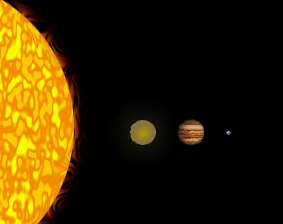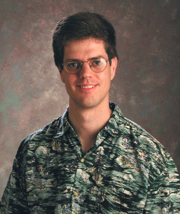9:00 a.m., June 25, 2003--Brown dwarfs, gaseous masses that are essentially failed stars, tend to form in pairs and in close proximity to one another, a University of Delaware scientist reports in the June issue of the Astronomical Journal.
 |
| This illustration shows the size of our sun (left) compared with a brown dwarf (second from left), Jupiter (third from left) and Earth (right). Credit: Brian Hewitt, NASA, Goddard Space Flight Center. |
John Gizis, UD assistant professor of physics and astronomy, said that in recent years researchers have been able to discover a large number of brown dwarfs, bodies that are greater in mass than gas-giant planets but not as massive as stars.
Brown dwarfs were first hypothesized in the 1970s, and the first indisputable evidence of their existence was discovered in 1995.
Since, scientists including Gizis have been making great strides in learning more about the brown dwarfs through use of the Hubble Space Telescope, which makes possible detailed measurements.
“We were interested in finding out if the brown dwarfs are sitting there by themselves or if they have companions,” Gizis said of his research, which was conducted using the Hubble last year. “We found that about 20 percent of the time, they are doubled, so brown dwarfs tend to form in pairs.”
He said data accumulated several years ago “pointed in that direction,” but that this finding “is based on much better data.”
New is his finding that “all of the binaries are fairly close.” The separations between the brown dwarfs are similar to the separation between the Sun and Jupiter, which, on a cosmic scale, are fairly close, he said.
Gizis said the finding has raised an important question: “Why do the brown dwarfs only form close pairs, not distant pairs?”
“Stars form both close pairs and distant pairs,” he said. “I think this finding was not expected beforehand at all.”
 |
| John Gizis, assistant professor of physics and astronomy
Photo by Kathy Atkinson
|
Gizis said he hopes to tackle that and other important questions about brown dwarfs during future sessions using the space telescope. For instance, because brown dwarfs tend to orbit one another, it will be possible in the future to measure their masses. Now, mass is merely estimated, he said.
“I hope to get time on the Hubble to study several brown dwarf systems in detail,” Gizis said.
Gizis earned his bachelor’s degree in physics and astronomy in 1992 and his doctorate in astronomy from the California Institute of Technology in 1998. He joined the UD faculty in 2001.
He is a member of the International Astronomical Union, the American Astronomical Society and the Astronomical Society of the Pacific.
Article by Neil Thomas
|

